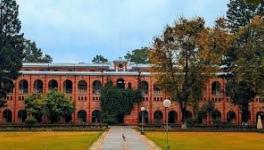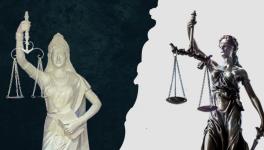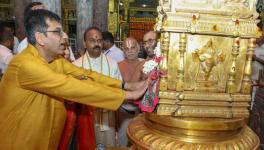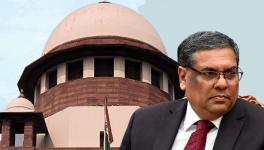Only Misleading Thing in Allahabad HC Judge’s Support for Majoritarian Rule is Use of Future Tense
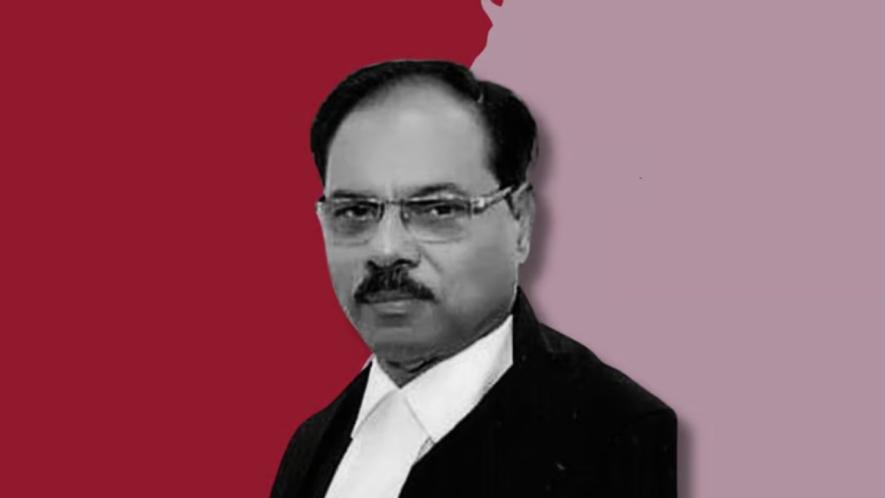
Justice Shekhar Kumar Yadav’s remarks have triggered controversy— not because they are extraordinary but because they are uncomfortably ordinary.
His speech on December 8 at the Vishwa Hindu Parishad (VHP) legal cell in Allahabad High Court is not just one individual’s worldview, it is a window into the judiciary’s rotting complicity in fostering majoritarian dominance while reconstructing statues of Lady Justice (who is she?).
The controversy lies not in his words alone but in their sheer alignment with a judiciary that seems intent on normalising majoritarianism as a national doctrine. His speech was an exhibition of both a majoritarian imagination and its legal scaffolding.
Justice Shekhar Yadav’s endorsement of a Uniform Civil Code (UCC) as a progressive framework for women’s rights and a unifying law for a nation of “Hindus”, regardless of their religion so long as they “love their motherland”, frames national unity as synonymous with a singular cultural identity, effectively erasing the pluralism and diversity enshrined in the Constitution.
The UCC, under majoritarian framing, is a tool of cultural homogenisation, disregarding the social, cultural and historical contexts that shape the lives of women and marginalised communities across the country.
A portion of the 180-year-old Noori Masjid in Uttar Pradesh’s Fatehpur district was razed during an anti-encroachment drive. The mosque is reportedly older than the road it is supposed to be encroaching upon. The mosque committee had sought relief from the Allahabad High Court, with the hearing scheduled for December 13.
When Justice speaks
Meanwhile, Justice Shekhar Kumar Yadav, a sitting judge of the same court, openly celebrated what he termed “the ancestors' struggle to release Ram Lalla’s janmabhoomi”.
Outsiders, Yadav said, misunderstand the term “Hindu”. According to him, Hinduism is not about rituals, prayers or religious markers. It is a broader identity encompassing all who live in this land, call it their motherland, and are ready to sacrifice for it.
“It does not matter if they follow the Quran or the Bible— they are also Hindu,” he said. While this sounds pluralistic on the surface, it is assimilation masquerading as inclusion— a familiar trick in the Hindutva playbook.
But Yadav did not stop at the definition of Hindu. His more telling statement was: “Hindustan will function on the basis of the majority.” That is the crux— not a slip of the tongue, but an open declaration of majoritarian rule.
The audacity to claim such dominance openly is not his alone, it is drawn from a system that cultivates and rewards such rhetoric. That is why he delivered his speech openly and allowed it to be broadcast over the internet so that everyone could watch it. Just like former CJI Dr D.Y. Chandrachud’s Ganesh puja with Prime Minister Narendra Modi, this was done to consciously attract attention.
The controversy lies not in his words alone but in their sheer alignment with a judiciary that seems intent on normalising majoritarianism as a national doctrine.
In his speech, Justice Yadav used the derogatory term “kathmullah” (chopped mullah, a slur against Muslims alluding to their circumcision), while asserting that Muslim children, raised witnessing animal slaughter could not exhibit kindness or tolerance. These remarks are troubling not only for their crassness but also for their stark communal bias, which raises questions about impartiality in his judicial conduct.
This bias is evident in his controversial judicial Orders, including State of Uttar Pradesh versus Javed, where Justice Yadav denied bail to a Muslim man accused of cow slaughter. In this Order, Justice Yadav's reasoning went beyond legal analysis. He stated that cows should be declared India's national animal.
His Order, written in Hindi, included scientifically baseless claims, such as “scientists believe that cows are the only animals that inhale and exhale oxygen”. He further extolled the virtues of panchgavya (a concoction made from the dung, urine, milk curd and ghee of cows), claiming it could cure incurable diseases and calling for laws to criminalise the consumption of cow meat.
His observation that “jab gaay ka kalyaan hoga, tabhi desh ka kalyaan hoga” (The nation will prosper when the cow prospers) starkly illustrates how his personal beliefs seep into judicial decisions.
Yadav also advocated for cow protection to be made a fundamental right for Hindus, suggesting that “the right to life is above the right to kill”, implicitly criminalising beef consumption and disregarding the rights of “others”.
In Javed Ansari versus State of UP (2021), Justice Yadav’s remarks revealed anti-Muslim sentiments, framing religious conversion, especially to Islam, as a national security threat.
By invoking the ‘love jihad’ trope, he demonised Muslim men, portraying conversions and interfaith relationships as forms of religious domination. His statements not only targeted Muslims but also disallowed religious conversions and interfaith romantic relationships, reinforcing harmful stereotypes and promoting intolerance.
The UCC, under majoritarian framing, is a tool of cultural homogenisation, disregarding the social, cultural and historical contexts that shape the lives of women and marginalised communities across the country.
This view not only ignores constitutional protections for freedom of religion but conflates individual actions with collective communal identity. This statement implicitly associates religious conversions, particularly those to Islam, with weakening the nation, invoking a divisive narrative of ‘us versus them’.
In the Akash Jatav versus State of Uttar Pradesh, Justice Shekhar Kumar Yadav (once again) made several controversial remarks that raised questions about the application of constitutional principles. The case involved a bail plea by Surya Prakash Jatav, accused of making obscene remarks against Lord Rama and Lord Krishna on Facebook, which the court deemed an insult to the faith of the majority and harmful to societal harmony.
He emphasised that Lord Rama and Krishna “reside in the heart of Indians” and that no one should be allowed to hurt the religious sentiments of others in the name of freedom of speech. He further cited examples such as the prohibition of cow slaughter during Eid, asserting that it safeguards the faith of other religions, framing such restrictions as necessary for societal harmony.
This statement conflicts with the broader constitutional principles of free expression, which permits individuals to criticise or question religious beliefs. His call for laws that ‘honour’ figures such as Lord Rama and Krishna, and his comparison of social media comments to criminal offences, lack logical grounding, revealing his own fanaticism.
Among the believers
It would be convenient to argue that such rhetoric is legally unsound, blurring the lines between religion and law. Yet, the Indian legal framework has long established precedents that normalise this fusion, reflecting a systemic alignment with majoritarian ideology. Instead of acting as a check on majoritarian excesses, the judiciary has become a participant in normalising exclusionary practices.
From the Ayodhya verdict, where the disputed land was awarded to the majority despite acknowledging the illegality of the Babri Masjid demolition, to the growing trend of constructing temples within police stations, the legal system often mirrors the cultural dominance of the majority.
These developments illustrate a judiciary that reinforces rather than resists majoritarianism. The celebrations surrounding the Ram Mandir pran pratishtha exemplify this alignment.
Regional and district Bar associations, alongside several high courts, observed holidays or restricted judicial activity to commemorate the event. The Gujarat High Court Bar, for instance, chanted Ram dhun in celebration.
His Order, written in Hindi, included scientifically baseless claims, such as: “Scientists believe that cows are the only animals that inhale and exhale oxygen.”
These spectacles signify the judiciary’s endorsement of a cultural narrative that privileges majoritarian sentiment. Similarly, the construction of temples within police stations raises critical questions: To whom is the law accessible when State authority is visibly intertwined with the religious symbols of the majority?
These trends exemplify what Evgeny Pashukanis, a Soviet legal scholar known for his Marxist approach to law, particularly through his General Theory of Law and Marxism (1924), described as the transformation of social relations into legal forms that serve the dominant class, legitimising their ideology as natural and just.
Pashukanis’ critique of law as a tool of the ruling class is instructive here. In The General Theory of Law and Marxism, he argued that legal norms reflect the material and ideological interests of the dominant class.
Justice Yadav’s rhetoric, and its institutional acceptance, exemplify how law is used to perpetuate majoritarian dominance. As Pashukanis suggested, law transforms antagonistic social relations into formalised structures that mask their class content. Citing Gumplowicz, Pashukanis adds another layer to this critique, arguing that legal norms emerge from conflict, not unity.
In this context, Justice Yadav’s framing of the UCC as a unifying force is ironic— it seeks to impose homogeneity under the guise of eliminating inequality, ignoring the underlying antagonisms it exacerbates.
The fact that this country is being redefined on the spectacle of demolishing a mosque to build a temple is, in itself, pitiful enough to understand that Justice Shekhar Yadav and his crass language are simply symptomatic of a rotting lot. The spectacle is not just symbolic, it is systemic and it lays bare the reality of a nation where such acts are celebrated as milestones of cultural reclamation.
To whom is the law accessible when State authority is visibly intertwined with the religious symbols of the majority?
While his accusatory and crass tone might seem alarming (and rightfully so), his ‘humble’ proclamations of majoritarian bigotry— hate specifically directed at Muslims— are a reflection of this nation’s current state.
When a system allows someone who hates with such audacity to wield great power, the malaise cannot be cured by taking action against a single individual. It is easy to demand immediate action against Justice Yadav as a judge, but what about the judiciary, the courts, the lawyers and the legislators who breed these anti-democratic ‘elements’ in the first place?
There is an empirical limit to the judicial logic that claims to implement or uphold the law. This blurs any immediate recourse to court for justice. While Justice Yadav asserts the genuineness of his bigotry in the name of citizenship, the systemic scapegoating and persecution of a section of the population vanish into the noise.
The question of citizenship— one that brought people to the streets in protest not long ago— endures, but only for those who have been forced to repeatedly prove their existence. For someone like Justice Yadav, a Hindu High Court judge, claiming the majoritarian mandate of law as the natural course of society is effortless. It is clear why: for him, being a citizen does not need interrogation.
Then there is the language— ghar wapsi, love jihad. The very choice of words constructs an ‘other’, carving out divisions from eating habits to how one looks, from who they love to where they pray. It is the inherent otherisation, one that does not just separate but dehumanises. And this language is not incidental— it is deliberate. It demarcates, polices and enforces a hierarchy in which only the majority can lay claim to legitimacy.
Justice Yadav’s speech is not just an individual’s reflection— it is the judiciary laid bare. It is the spectacle of a democracy pretending to function while the structure beneath it rots. His speech is a symptom of a democracy grappling with its inability— or unwillingness— to uphold pluralism.
For someone like Justice Yadav, a Hindu High Court judge, claiming the majoritarian mandate of law as the natural course of society is effortless.
On the same day when Justice Yadav was spewing hate against a marginalised minority in India, a senior rebel commander in war-torn Syria, Anas Salkhadi, appeared on State TV hours after Damascus fell to the rebels, to declare, “Our message to all the sects of Syria is that we tell them that Syria is for everyone.”
When people formerly associated with the Islamic State of Iraq and Syria (ISIS) and Al Qaeda (and ‘kathmullahs’ to boot!) sound more tolerant and attuned to the rule of law than a sitting judge of a constitutional court in the world’s largest democracy, could there be a clearer sign that minorities in India face a bleak future till the cows come home?
Get the latest reports & analysis with people's perspective on Protests, movements & deep analytical videos, discussions of the current affairs in your Telegram app. Subscribe to NewsClick's Telegram channel & get Real-Time updates on stories, as they get published on our website.











